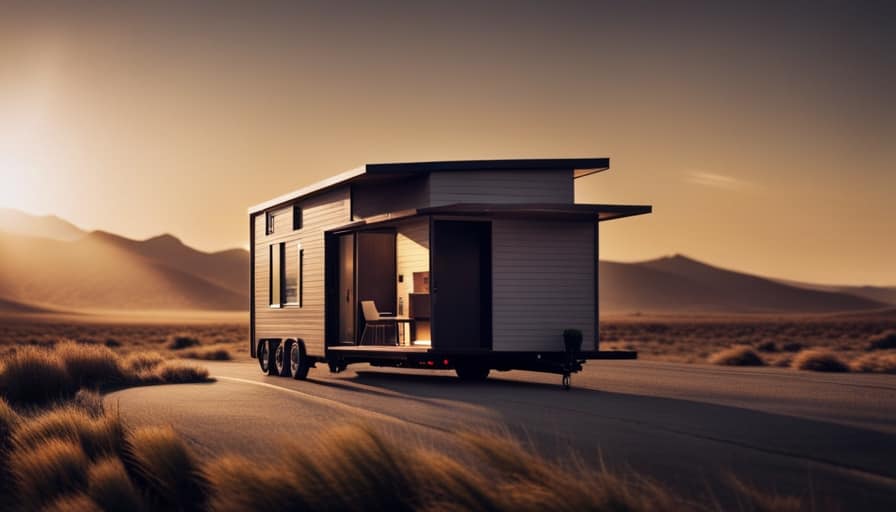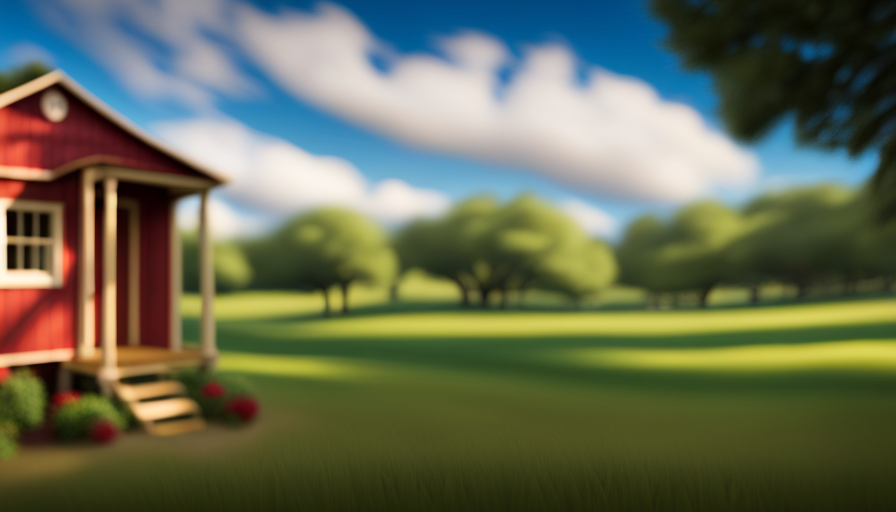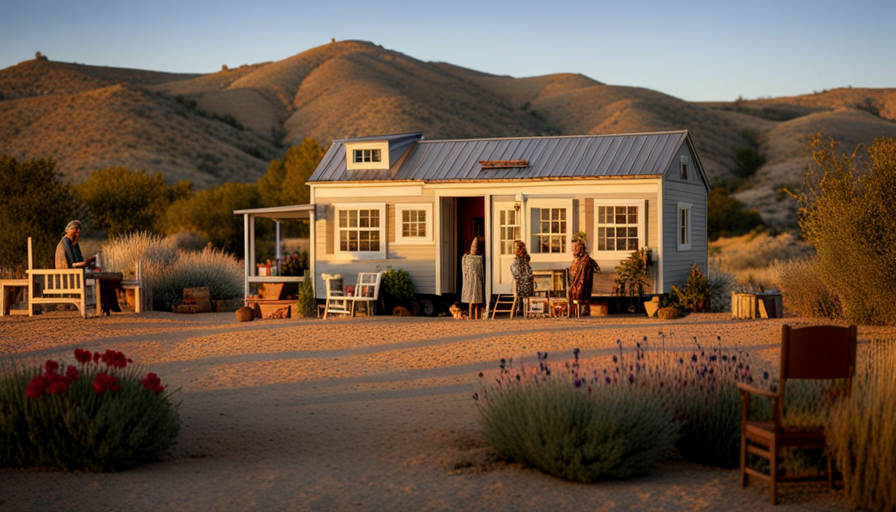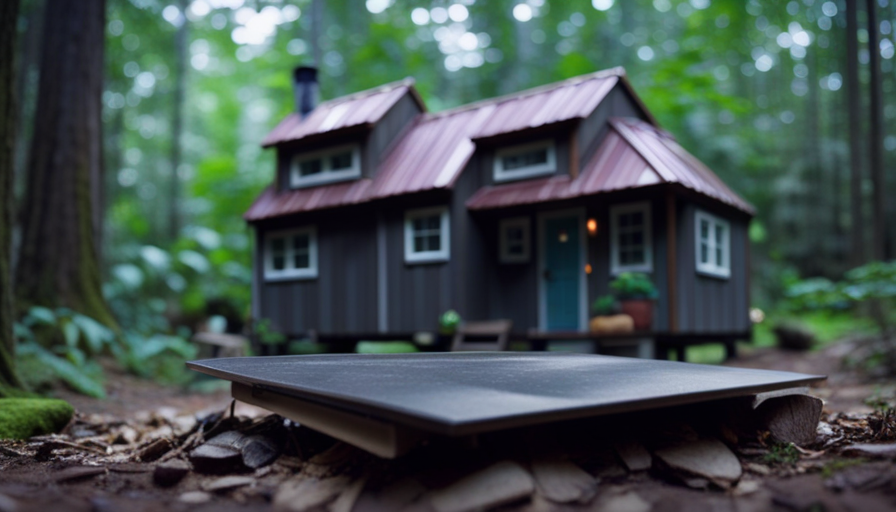Being a fan of minimalism and eco-friendly living, I have come across the secret treasure of the deep gravel tiny house.
This unique dwelling not only offers a cozy and efficient living space, but also embraces the beauty of nature.
With its minimalistic design and eco-friendly features, the deep gravel tiny house is a true sanctuary.
Join me as I delve into the world of this extraordinary living concept and explore the countless benefits it has to offer.

Key Takeaways
- Deep gravel tiny houses offer a cozy and efficient living space that embraces the beauty of nature while featuring a minimalistic design.
- The cost of building a deep gravel tiny house ranges from $20,000 to $50,000, excluding land and permits, and finding suitable land can be challenging due to zoning regulations.
- Living in a deep gravel tiny house provides cost-effective living, encourages a decluttered and minimalist lifestyle, allows for a nomadic lifestyle, and promotes environmental sustainability.
- Designing the perfect deep gravel tiny house involves maximizing functionality and comfort, optimizing space, utilizing multifunctional furniture, and incorporating storage solutions that maximize vertical space.
The Deep Gravel Tiny House: An Introduction
As I begin to explore the concept of the Deep Gravel Tiny House, I’m fascinated by its unique design and potential.
The cost of building a Deep Gravel Tiny House can vary depending on factors such as size, materials used, and location. On average, it can range from $20,000 to $50,000. However, it’s important to note that this cost doesn’t include the land or any additional permits that may be required.
Speaking of permits, one of the challenges of zoning regulations for Deep Gravel Tiny Houses is that they’re often not specifically addressed in existing regulations. This can make it difficult to find suitable land or navigate the legal requirements.
It’s crucial to research local zoning laws and work with professionals who’ve experience in this area to ensure compliance and a smooth process.
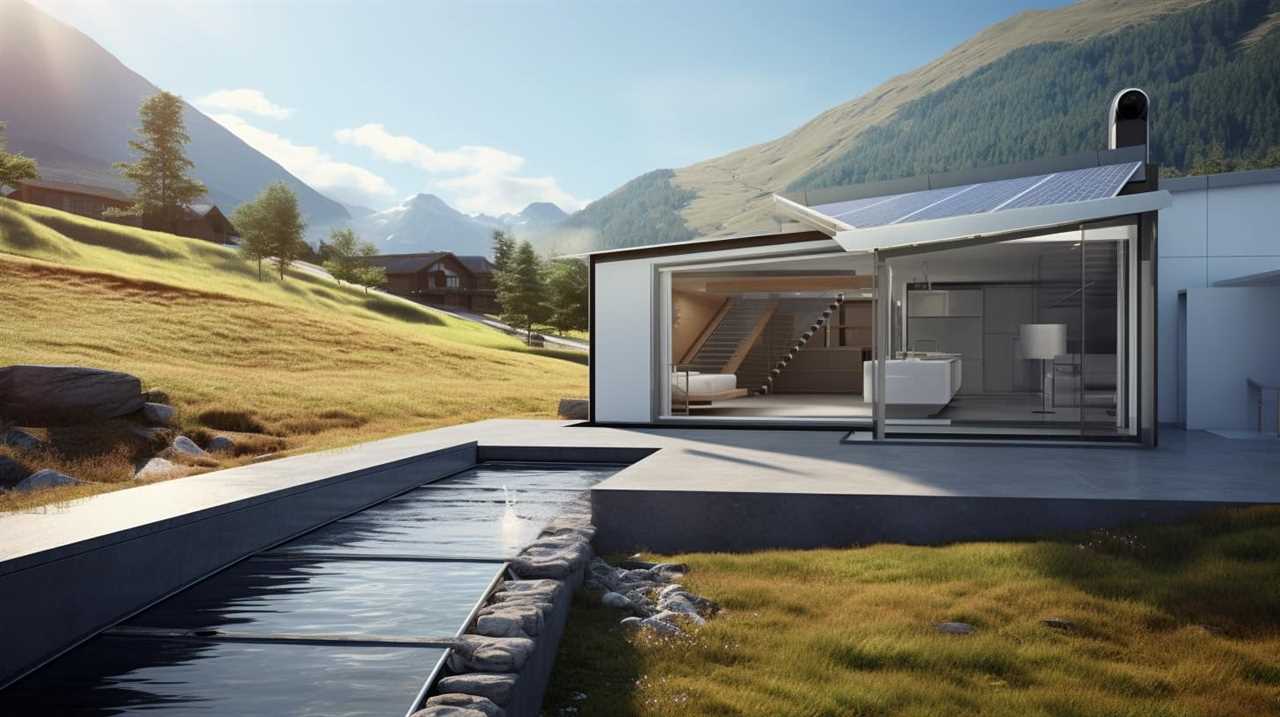
The Benefits of Living in a Deep Gravel Tiny House
For me, living in a Deep Gravel Tiny House offers a sense of freedom and simplicity. The advantages of this lifestyle are numerous. Firstly, the cost of living is significantly reduced. With a smaller space to heat, cool, and maintain, utility bills are minimized. Additionally, the compact size encourages a decluttered and minimalist lifestyle, allowing for a more organized and stress-free living environment. Secondly, the mobility of a tiny house on deep gravel allows for a nomadic lifestyle, giving the freedom to travel and explore new places while still having a cozy and comfortable home. Lastly, living in a deep gravel tiny house promotes environmental sustainability. The smaller footprint reduces energy consumption and encourages the use of eco-friendly materials. Overall, the deep gravel tiny house lifestyle offers a unique and fulfilling way of living, combining simplicity, freedom, and sustainability.
| Advantages | Lifestyle |
|---|---|
| Cost-effective | Decluttered and minimalist |
| Mobility | Nomadic lifestyle |
| Environmental sustainability | Cozy and comfortable home |
Designing the Perfect Deep Gravel Tiny House
One of the key considerations when designing the perfect deep gravel tiny house is to ensure that the space is maximized for functionality and comfort. Designing challenges in such a small space can be quite daunting, but with careful planning and creativity, it’s possible to create a space that feels spacious and efficient.
Space optimization is crucial in a deep gravel tiny house, as every square inch counts. Utilizing multifunctional furniture, such as a sofa that can be converted into a bed or a dining table that can be collapsed when not in use, is a great way to save space.
Additionally, incorporating storage solutions that maximize vertical space, such as wall-mounted shelves and cabinets, can help keep the living area clutter-free. By carefully considering the challenges of designing in a small space and prioritizing space optimization, the perfect deep gravel tiny house can be achieved.
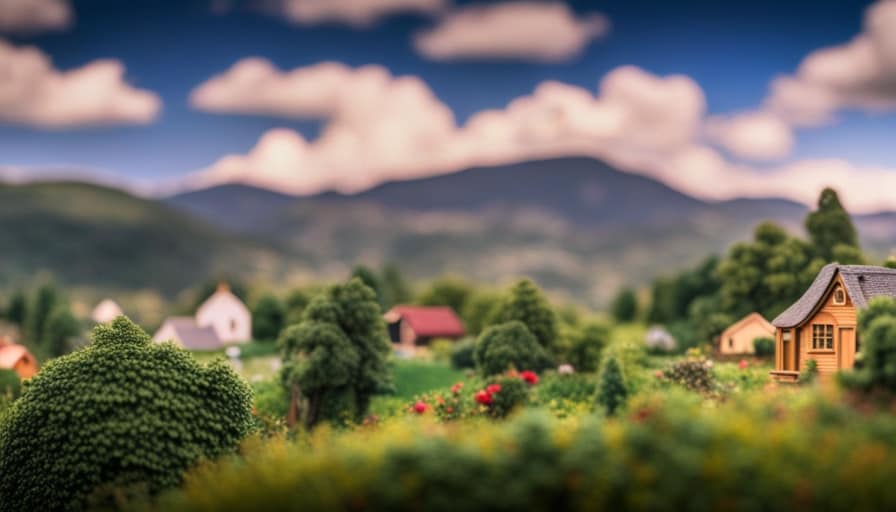
Sustainable Features of the Deep Gravel Tiny House
I love the sustainable features of my Deep Gravel Tiny House. One of the key aspects of its eco-friendliness is the use of environmentally friendly materials. From the renewable bamboo flooring to the reclaimed wood accents, every element of the house is chosen with sustainability in mind.
The energy-efficient design is another highlight. The house is equipped with solar panels that power the entire space, reducing reliance on non-renewable energy sources. Additionally, the well-insulated walls and energy-efficient appliances help minimize energy consumption.
These sustainable features not only reduce the environmental impact of the house but also contribute to a more comfortable and cost-effective living experience.
Now that you know about the sustainable features, let’s move on to some tips for making the most of your deep gravel tiny house space.
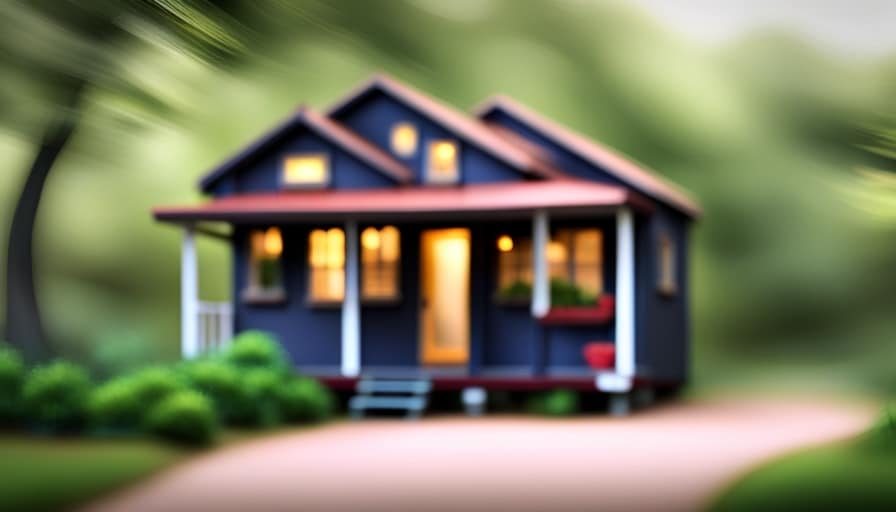
Tips for Making the Most of Your Deep Gravel Tiny House Space
To maximize your deep gravel tiny house space, utilize clever storage solutions and multifunctional furniture.
Maximizing storage is essential in a small living space like a deep gravel tiny house. Consider using vertical storage options such as shelves or hanging organizers to make the most of your walls. Utilize under-bed storage containers or drawers to keep your belongings organized and out of sight.
Another great way to maximize storage is by using furniture that serves multiple purposes. Look for sofas and chairs that can also be used as storage units, or tables that can be extended or folded down when not in use.
Frequently Asked Questions
What Are the Dimensions of a Deep Gravel Tiny House?
The dimensions of a deep gravel tiny house depend on the specific design and preferences of the builder. However, typical dimensions range from 8 to 30 feet in length and 8 to 12 feet in width.
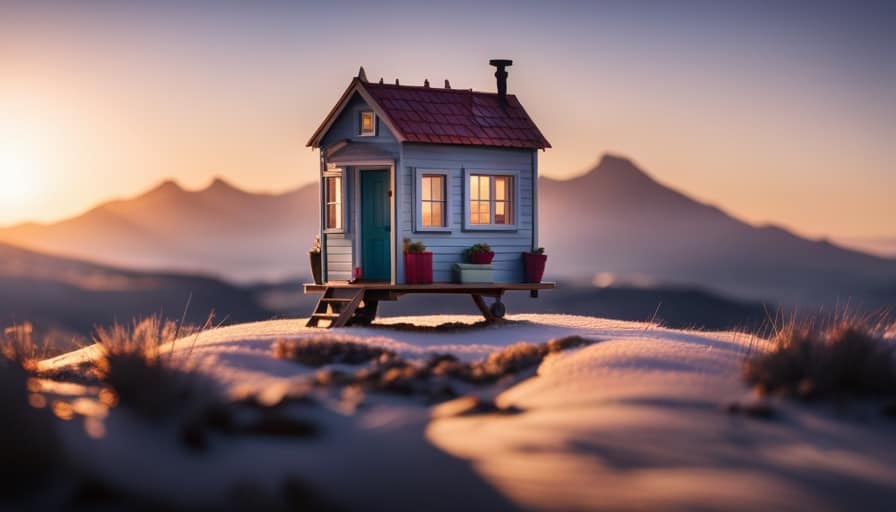
How Much Does It Cost to Build a Deep Gravel Tiny House?
Building a deep gravel tiny house can cost around $30,000 to $60,000, depending on various factors such as size, materials, and location. Construction typically takes several months, with careful planning and attention to detail ensuring a beautiful and functional home.
Can I Customize the Layout and Design of a Deep Gravel Tiny House?
Yes, you can customize the layout and design of a Deep Gravel Tiny House. There are various customization options available, allowing you to make interior design choices that suit your preferences and needs.
Is It Possible to Live in a Deep Gravel Tiny House off the Grid?
Living off grid in a deep gravel tiny house is definitely possible. With careful planning and sustainable practices, you can harness renewable energy sources, collect rainwater, and minimize your environmental impact while enjoying a simpler, self-sufficient lifestyle.
Are There Any Specific Permits or Regulations I Need to Consider When Building a Deep Gravel Tiny House?
When building a deep gravel tiny house, it’s essential to consider permit requirements and construction regulations. It’s important to research and comply with local regulations to ensure a safe and legal build.

Conclusion
In conclusion, the Deep Gravel Tiny House offers a unique and sustainable living experience. With its innovative design and use of sustainable features, it provides a comfortable and eco-friendly living space.
Living in a Deep Gravel Tiny House allows you to minimize your environmental impact while still enjoying all the comforts of a traditional home.
So, why settle for ordinary when you can live in a Deep Gravel Tiny House and experience the extraordinary?
I’m Theodore, and I love tiny houses. In fact, I’m the author of Tiny House 43, a book about tiny houses that are also tree houses. I think they’re magical places where imaginations can run wild and adventures are just waiting to happen.
While tree houses are often associated with childhood, they can be the perfect adult retreat. They offer a cozy space to relax and unwind, surrounded by nature. And since they’re typically built on stilts or raised platforms, they offer stunning views that traditional homes simply can’t match.
If you’re looking for a unique and romantic getaway, a tree house tiny house might just be the perfect option.
